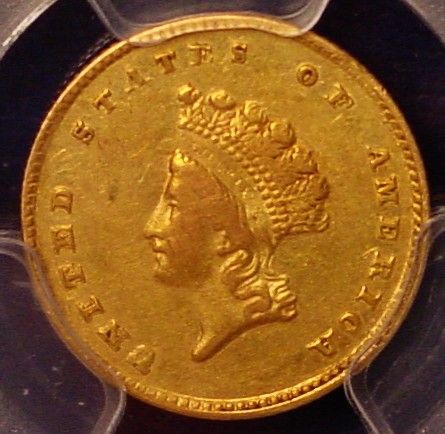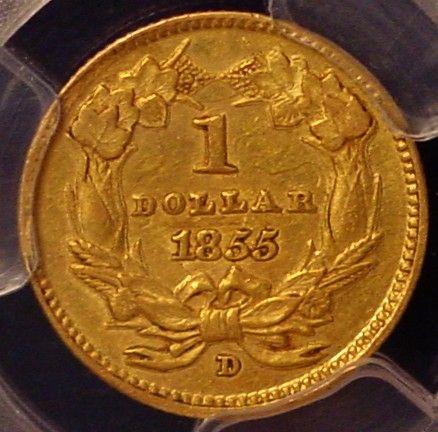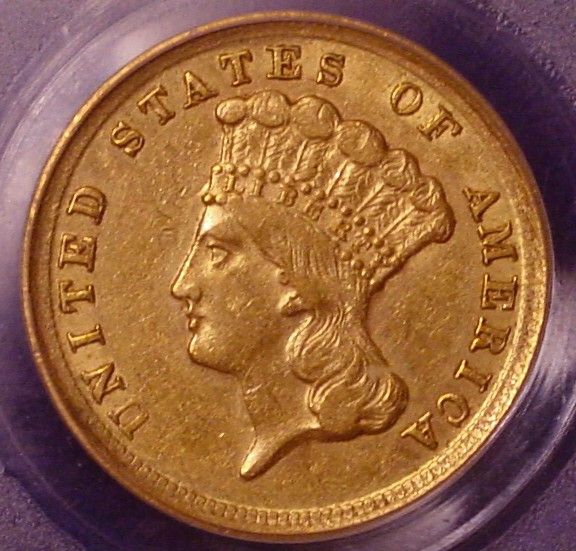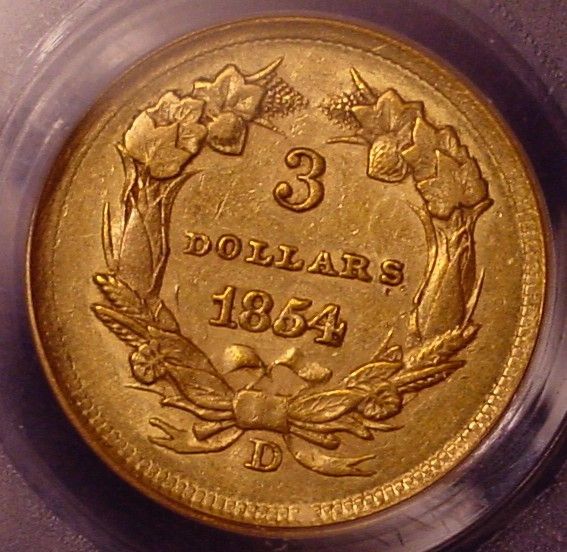Trying to balance your collection of really scarce coins
All of us would like to acquire every coin in Choice or Gem Mint State, but that is not possible. First "the best of the best" carry prices that are far beyond the financial means of most of us. Further, if you collect some really scarce coins that were seldom saved and/or poorly made at the mint from which they came, you chances of getting coins of equal quality to the more common pieces in your collection are virtually nonexistent.
This has been the dilemma I have had with my Dahlonega mint collection. I have been working on a set of Type I gold dollars, and I have been trying to put together a Dahlonega mint type set. This set consists of three gold dollars (Types I, II, and III), a Classic Head $2.50, a Liberty Head $2.50, the one year type Three Dollar Gold Piece, the Classic Head $5 gold and the Liberty Head $5 Gold. The specialists insist that you also need the $5 Liberty gold piece with the mint mark on the obverse (1839-D), but I have chosen to ignore that one, at least for the moment. As a conventional type collector, one would need, for example, a Walking Liberty half dollar with a obverse mint mark, but that is never included in the set. Therefore, I don't feel that I need that coin for the Dahlonega gold set.
I have been fortunate enough to get a few Dahlonega mint coins in Mint State, but those pieces have been the exception. For the most part AU has been the best that I could do and of late I have dropped back to EF-45. This leaves the consideration, how low in grade can you go and still have a set that looks like the coins are on a similar plain with respect to preservation. To me buying an AU or Mint State coin and then buying a well worn or damaged piece to go in the same set just does not look right unless you have no alternatives.
This week I bought the toughest Dahlonega type coin of them all, the 1855-D gold dollar. This coin had a mintage of only 1,811 pieces, and it has been estimated that only about 80 examples exist today in all grades. Most of those coins are well worn, cleaned and/or damaged, and many were poorly struck. Despite the low mintage, the Dahlonega mint personnel used two reverse dies. One of those dies produced a strong strike with a fully readable date, which was unusual even for a Philadelphia mint Type II gold dollar. Therefore the appearance of any undamaged, well struck example of the 1855-D gold dollar with the strong reverse is somewhat of a numismatic event. Add to that a piece that has not been cleaned, processed or "conserved," and it is an even bigger event.
So here is my new 1855-D gold dollar. PCGS graded it EF-45, but when I take a close look at it, I'd say that it could have been graded AU-50 or even 53 given the amount of mint luster that is between the devices, especially on the reverse. It stands up quite well to my 1854-D Three Dollar gold piece, which is graded AU-55, CAC.


And here is my 1854-D $3 gold


This has been the dilemma I have had with my Dahlonega mint collection. I have been working on a set of Type I gold dollars, and I have been trying to put together a Dahlonega mint type set. This set consists of three gold dollars (Types I, II, and III), a Classic Head $2.50, a Liberty Head $2.50, the one year type Three Dollar Gold Piece, the Classic Head $5 gold and the Liberty Head $5 Gold. The specialists insist that you also need the $5 Liberty gold piece with the mint mark on the obverse (1839-D), but I have chosen to ignore that one, at least for the moment. As a conventional type collector, one would need, for example, a Walking Liberty half dollar with a obverse mint mark, but that is never included in the set. Therefore, I don't feel that I need that coin for the Dahlonega gold set.
I have been fortunate enough to get a few Dahlonega mint coins in Mint State, but those pieces have been the exception. For the most part AU has been the best that I could do and of late I have dropped back to EF-45. This leaves the consideration, how low in grade can you go and still have a set that looks like the coins are on a similar plain with respect to preservation. To me buying an AU or Mint State coin and then buying a well worn or damaged piece to go in the same set just does not look right unless you have no alternatives.
This week I bought the toughest Dahlonega type coin of them all, the 1855-D gold dollar. This coin had a mintage of only 1,811 pieces, and it has been estimated that only about 80 examples exist today in all grades. Most of those coins are well worn, cleaned and/or damaged, and many were poorly struck. Despite the low mintage, the Dahlonega mint personnel used two reverse dies. One of those dies produced a strong strike with a fully readable date, which was unusual even for a Philadelphia mint Type II gold dollar. Therefore the appearance of any undamaged, well struck example of the 1855-D gold dollar with the strong reverse is somewhat of a numismatic event. Add to that a piece that has not been cleaned, processed or "conserved," and it is an even bigger event.
So here is my new 1855-D gold dollar. PCGS graded it EF-45, but when I take a close look at it, I'd say that it could have been graded AU-50 or even 53 given the amount of mint luster that is between the devices, especially on the reverse. It stands up quite well to my 1854-D Three Dollar gold piece, which is graded AU-55, CAC.


And here is my 1854-D $3 gold


Retired dealer and avid collector of U.S. type coins, 19th century presidential campaign medalets and selected medals. In recent years I have been working on a set of British coins - at least one coin from each king or queen who issued pieces that are collectible. I am also collecting at least one coin for each Roman emperor from Julius Caesar to ... ?
0
Comments
It stands up very well along the AU $3.
I know you are a retired dealer but it sure seems that you have the pedal to the floor, are very busy, and haven't slowed down one bit.
"If I say something in the woods and my wife isn't there to hear it.....am I still wrong?"
My Washington Quarter Registry set...in progress
Here is a P55 for comparison.
Joseph J. Singleton - First Superintendent of the U.S. Branch Mint in Dahlonega Georgia
Findley Ridge Collection
About Findley Ridge
Latin American Collection
<< <i>So you finally found one, and full date too. It is estimated that less than 2 dozen full dates exist. Looks awfully nice for a 45. IMO the 55-D Dollar is the toughest D-mint dollar period. Congrats. >>
There was an 1861-D in the same auction that was also graded EF-45. It was okay, but kind of dull and unexciting. When I looked at the Coin Facts census data, EF-45 is actually a bit down in the pecking order for that rare coin. I think that the 1855-D is harder to find nice.
The full date is very, very tough to find.
<< <i>Given the price I had pay for this, it needs to be an AU-50 coin or more. The darn thing caught fire caught fire at the auction.
It's the full date. They are in strong hands and just don't come to market. Mine was auctioned raw by Stacks back in April 2006. I must admit, after checking the auction hammer it did put a bit of smile on my face.
Joseph J. Singleton - First Superintendent of the U.S. Branch Mint in Dahlonega Georgia
Findley Ridge Collection
About Findley Ridge
We'll use our hands and hearts and if we must we'll use our heads.
<< <i>Agreed that the TPG some times play roulette with poorly produced coins esp ones where detail is naturally missing due to strike. Yours seems to be a net graded AU. Almost the very reason so many get dipped in the first place to get luster bump back into AU. Another winner in your camp, well done. That said I see the difference between the other exceptional au55 posted. >>
If some of the crust had been taken off of my piece, it would have been brighter, but it is definitely not as good the JJSingleton piece.
Collectors at all levels encounter this same frustration, but you've set for yourself an exceedingly high bar. If every piece in the collection is required to be visually similar and of uniform quality, there aren't too many series that are even worth starting. I'm slowly plodding toward a US design set. It spans everything from 18th century rarities to US Pres bucks. The registry says I'm currently at 68.42% completion yet I couldn't trade the entire collection for a single quality Half Disme in Fine. What's a guy to do?
I dunno. For me it comes down to collecting what's fun and breaking the rules when I feel like it. In your case, you've found the needle in the haystack. If the needle is a little bent & rusted, so what? Sometimes the most meaningful coin in a set is the one with the homeliest appearance. This 55-D is a good distance better than that! Who really cares what it grades? Even the most carefully matched collection in the world is broken down and scattered to the winds eventually anyhow.
"Have fun with your coins" is the most succinct and useful advice I've ever seen in regards to this thing we do. Finding and closing the deal to acquire this coin surely qualified.
Tom
BTW - the clash is so deep on the reverse of JJSingleton's piece that the obverse could be stacked in it to save space in a roll.
and it sets us apart from practitioners and consultants. Gregor
<< <i>
<< <i>So you finally found one, and full date too. It is estimated that less than 2 dozen full dates exist. Looks awfully nice for a 45. IMO the 55-D Dollar is the toughest D-mint dollar period. Congrats. >>
There was an 1861-D in the same auction that was also graded EF-45. It was okay, but kind of dull and unexciting. When I looked at the Coin Facts census data, EF-45 is actually a bit down in the pecking order for that rare coin. I think that the 1855-D is harder to find nice. >>
You are correct on both points. The 61-D dollar was obviously put away by many who recognized the confederate connection early on. Most known pieces are MS-AU and they show up at auction several times a year. The 55-D is very hard to find in those grades and rarely shows up at auction, especially with full date. The 61-D gets the glamour because of the confederate connection, but the 55-D with full date is rarely seen. Although about 70 exist the demand is huge. Like your 54-D $3, you have to have one to complete the 9 pc
Joseph J. Singleton - First Superintendent of the U.S. Branch Mint in Dahlonega Georgia
Findley Ridge Collection
About Findley Ridge
<< <i>For a single year proof set or mint set, it's worth trying to find coins in the same grade with similar toning and strikes. For a type or series collection it does not seem necessary that the coins are of similar condition, especially when dealing with extremely rare dates. >>
You are correct to point. If you are collecting large cents by Sheldon variety, you are going to have accept some low grade coins or none at all because that is what exists.
If you are generalist, like I am, you want a certain level of balance. For example I have 1796 Quarter in VF-25, that is pretty much a flawless coin for the grade. That is okay. My 1796 half dollar, which is much scarcer coin, is a Fine-15. That is one type coin in my set which I wish made the VF grade. It's not really close to it, but that was what was available.
With gold coins, higher grades are expected. I've been looking for an 1838-C half eagle for a while. I spotted a no problem Fine-15 at the summer FUN show, but if you put that next to my other coins which are now lower than EF-45, it simply looks out of place.
Joseph J. Singleton - First Superintendent of the U.S. Branch Mint in Dahlonega Georgia
Findley Ridge Collection
About Findley Ridge
I invite you to visit my numismatic eBay store https://ebay.com/str/numismaticswithkenny
<< <i>Just to be funny, I almost clicked the "make offer to owner" tab on HA.
Yea, would you like to bail me out? That would include the Heritage commission.
As of right now, I think not. I'm having too much fun with the coin right now. It's one of those coins, like the 1854-D Three Dollar Gold Piece, that I thought I'd never own. I'm a dedicated collector with little bit of economic sense, although I may have lost it with this purchase.